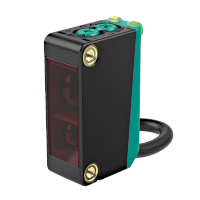Reliable Detection in PCB Production with ML100 Sensor
Convergent Beam Sensor Detects Different Kinds of PCBs

The Application
The PCB (printed circuit board) industry forms the backbone of the electronics industry. Almost all electronics products contain some form of PCB. These boards connect various components together with copper traces. Various types of machines are needed to process and move the PCBs. Some examples of these machines are conveyors, buffers, marking machines, loaders and unloaders, and traffic controllers. During the entire production process, the PCBs need to be reliably detected in order to determine their location for further processing.
The Goal
The detection of PCBs is by no means a straightforward task. Some challenges are different colors, textures, and reflectivity (from dull matt to shiny) of the PCB surface. Further challenges are non-detection of holes and notches in the PCB or non-detection of shiny background objects. Other tasks would be the detection of components on PCBs or the accurate detection of PCB edges to determine an accurate stop position. Furthermore, the sensors used for detecting the PCBs need to be very small in order to fit into the machines and need to offer simple mounting, where ideally no adjustment is needed.
The Solution

ML100-8-HGU-100-RT/102/115/162 convergent beam sensor
The ML100 convergent beam sensor is the best solution for the application due to a few properties. First, the sensor offers an elongated light spot, which ensures that even under travel over holes and notches on the PCB, the device remains in the “ON” state. This is because the light spot ignores the holes and notches while the other portion of the light spot is still detecting the PCB. Secondly, the sensors’ slim and well-defined light stop enables accurate detection of the stop position. And thirdly, the sensor reliably detects PCBs with all types of color and texture due to its superior optical design. In summary, the elongated light spot and the excellent optical performance are the key to the success of the sensor in this application. With this configuration, the sensor detects the PCB once it enters the light spot and does not switch off when it travels the length of the entire PCB. When moving the PCB perpendicular to the length of the light spot, the sensor ensures that the stop position is accurate as determined by the slim light spot.
Technical Features:
- Stable detection on all surfaces, including shiny PCBs
- Elongated light beam ignores holes and notches on PCBs
- Accurate detection of PCB position due to slim light spot
- Excellent optical performance for stable detection of different PCBs
The Advantages
The ML100 convergent beam sensor has excellent optical performance and therefore little issues detecting PCBs of various reflectivity. In addition, mounting and aligning the ML100 series is simplified by a red emitter LED and integrated all-metal threaded bushings. The switching states are also easily visible from all directions due to the highly visible LEDs.
At a Glance
- PCB production in the electronics industry
- Detection of surfaces with different colors, textures, and reflectivity
- Small mounting space requires a small sensor
- Elongated light spot and excellent optical performance for stable detection of different PCBs








 +49 621 776-0
+49 621 776-0